
SALT for Preschoolers
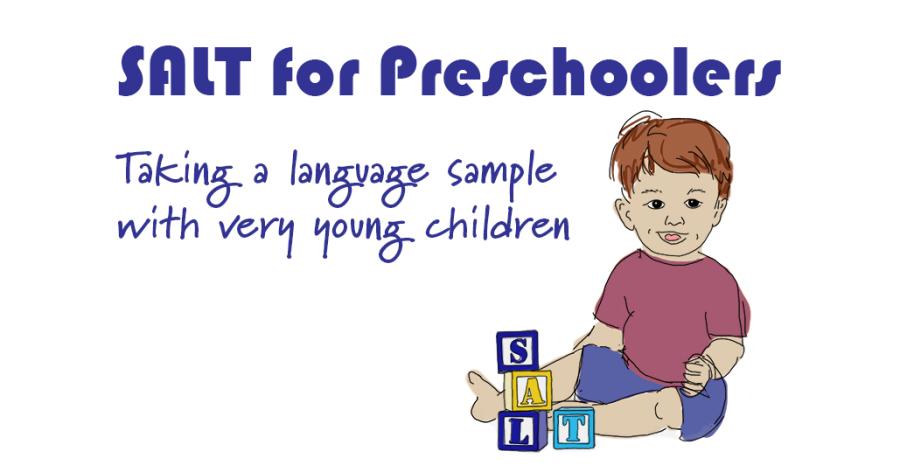
SALT for Preschoolers
Published at: 2021-07-10
Did you know that SALT is a great tool to use when assessing very young children?
Many users think of SALT as a tool for school-aged children. While SALT does offer several databases for school-aged children, language sample analysis should also be in every clinician’s toolbox when assessing the very young and preschool-aged children as well!
Taking a language sample with very young children and preschoolers can set the stage for assessing language acquisition and for progress monitoring. The SLP can closely monitor the number of words and the types of words, for example. Is the child using nouns only? Is the child starting to use different word types? SALT reports will quickly generate this data for you. Sometimes it is the little things that matter, and SALT measures the little things!
Even if the child has limited oral language, it is worth the time to transcribe the sample to get a baseline of expressive language functioning that you can later reflect on and compare to a time-two language sample. By taking samples across time, you can measure growth in vocabulary, different word types, pragmatic skills and more. In fact, language sampling works well because you can take a language sample as frequently as you feel necessary. There is no limit on how often you can take a conversational language sample.
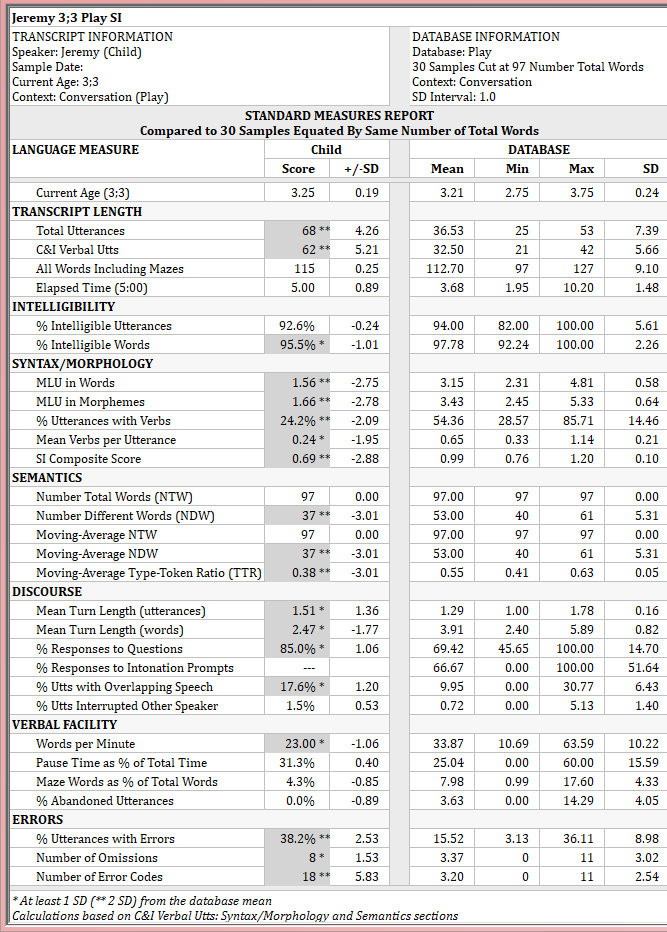 Conversation (norm: keeps a conversation going)
Report: Standard Measures Report or Discourse Summary
Conversation (norm: keeps a conversation going)
Report: Standard Measures Report or Discourse Summary
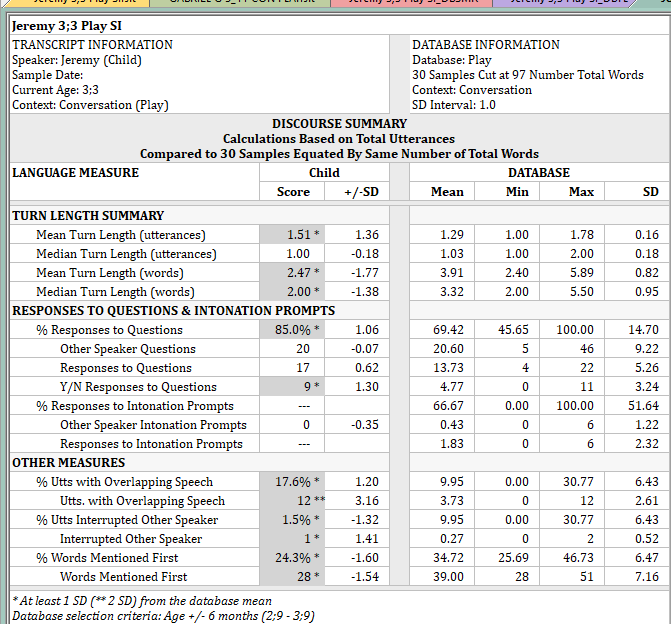
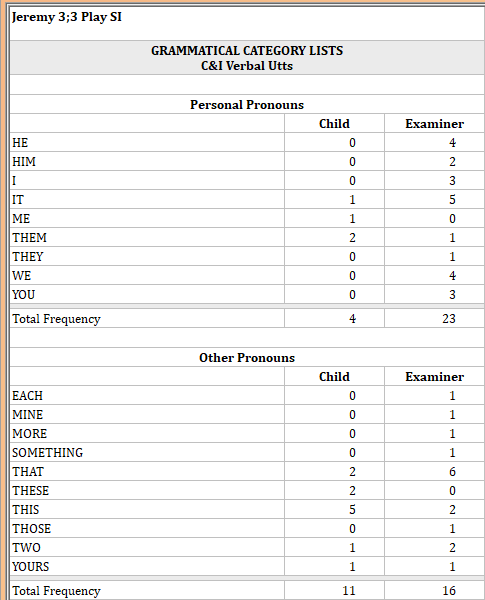 Plurals (norm: uses some plural words)
Report: Bound Morpheme
Plurals (norm: uses some plural words)
Report: Bound Morpheme
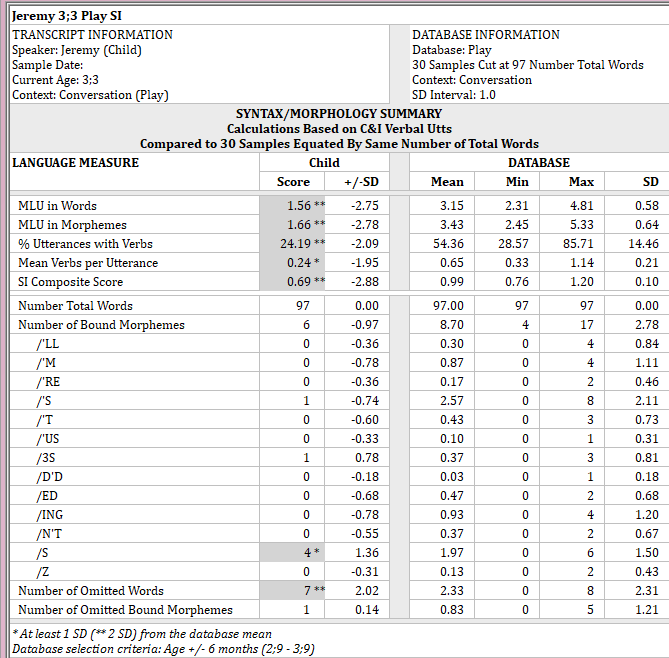
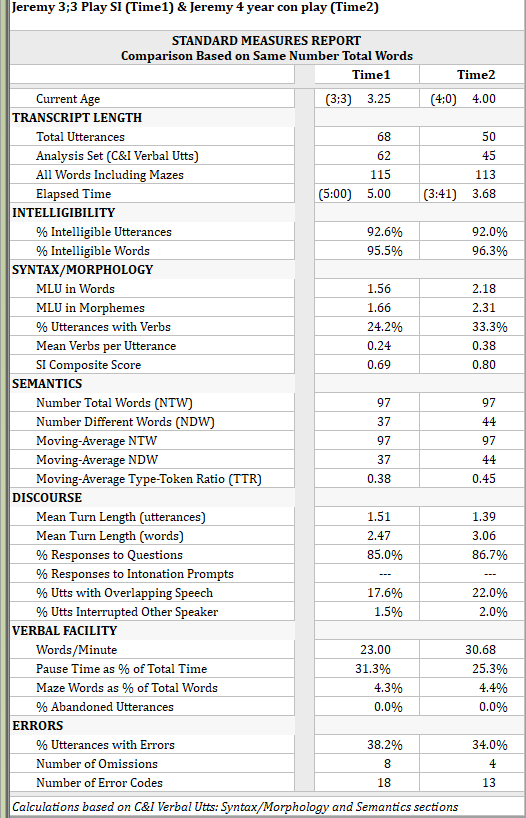 SALT can help your evaluation to get a baseline of any amount of language. You’ll have the data to measure general skills and specific skills and to look at growth over time. Make language sample analysis part of your assessment, even for the littles!
SALT can help your evaluation to get a baseline of any amount of language. You’ll have the data to measure general skills and specific skills and to look at growth over time. Make language sample analysis part of your assessment, even for the littles!
What type of language sample should I collect?
Play-based language samples are the most appropriate for preschool-aged children. Children are most likely to be most at ease and comfortable in a naturalistic play environment. SALT offers a play-based conversational database to compare your sample against. Database: Typically developing participants, ranging in age from 2;8 - 5;8, drawn from preschools and kindergarten classrooms Elicitation Protocol: The database samples were elicited with an examiner engaged in play with the child. The SLP should follow the child’s lead and participate in play with the child. Tips to elicit the best play-base language sample include:- Make comments rather than ask yes/no questions.
- Ask for clarification (if needed), and get down on the child’s level.
- Toys that can be manipulated work best. Farm sets, castles, play-doh, or Mr. Potato Head work well.
What should I be looking for?
ASHA’s web page (https://www.asha.org/public/speech/development/23/) lists some general expressive language developmental norms by age which we are all pretty familiar withTypical Developmental Norms:
Age 2-3 Has a word for almost everything. Talks about things that are not in the room. Uses words like in, on, and under. Uses two- or three- words to talk about and ask for things. Asks “Why?” Puts 3 words together to talk about things. May repeat some words and sounds. Age 3-4 Answers simple who, what, and where questions. Says rhyming words, like hat–cat. Uses pronouns, like I, you, me, we, and they. Uses some plural words, like toys, birds, and buses. Asks when and how questions. Puts 4 words together. May make some mistakes, like “I goed to school.” Talks about what happened during the day. Uses about 4 sentences at a time. Age 4-5 Responds to “What did you say?” Talks without repeating sounds or words most of the time. Names letters and numbers. Uses sentences that have more than 1 action word, like jump, play, and get. May make some mistakes, like “Zach gots two video games, but I got one.” Tells a short story. Keeps a conversation going. Talks in different ways, depending on the listener and place. Your child may use short sentences with younger children. He may talk louder outside than inside.What can I analyze?
Based on the expressive language skills we expect to be developmentally appropriate we can run reports in SALT to quantify those skills. SALT also can generate very specific data on language measures. Here are just a few examples of developmental norms and the corresponding SALT report based on a play-based language sample from a three-year old speaker.General Skills:
Mean Length of Utterance (norm: puts 2,3,4 words together). MLU can be easily tracked over time 1/time 2 language samples. Report: Standard Measures Report Conversation (norm: keeps a conversation going)
Report: Standard Measures Report or Discourse Summary
Conversation (norm: keeps a conversation going)
Report: Standard Measures Report or Discourse Summary

Specific Skills:
Preposition Words (norm: uses words like in, on, under). Report: Grammatical Categories Report Plurals (norm: uses some plural words)
Report: Bound Morpheme
Plurals (norm: uses some plural words)
Report: Bound Morpheme

Monitor Changes
Our goal is always to increase language skills. Time one/Time two samples are a way to document changes in language skills. By linking two samples collected using the same elicitation protocol, we can look at data side-by-side to easily see the changes. Report: The Standard Measures Report Below details two play-based language samples taken approximately seven months apart. SALT can help your evaluation to get a baseline of any amount of language. You’ll have the data to measure general skills and specific skills and to look at growth over time. Make language sample analysis part of your assessment, even for the littles!
SALT can help your evaluation to get a baseline of any amount of language. You’ll have the data to measure general skills and specific skills and to look at growth over time. Make language sample analysis part of your assessment, even for the littles!
No Comments yet. Be the first to comment.